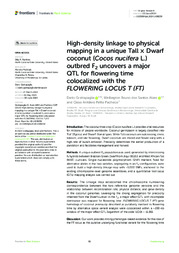High-density linkage to physical mapping in a unique Tall × Dwarf coconut (Cocos nucifera L.) outbred F2 uncovers a major QTL for flowering time colocalized with the FLOWERING LOCUS T (FT).
High-density linkage to physical mapping in a unique Tall × Dwarf coconut (Cocos nucifera L.) outbred F2 uncovers a major QTL for flowering time colocalized with the FLOWERING LOCUS T (FT).
Author(s): GRATTAPAGLIA, D.; ALVES, W. B. dos S.; PACHECO, C. A. P.
Summary: Introduction: The coconut tree crop (Cocos nucifera L.) provides vital resources for millions of people worldwide. Coconut germplasm is largely classified into ‘Tall’ (Typica) and ‘Dwarf’ (Nana) types. While Tall coconuts are outcrossing, stress tolerant, and late flowering, Dwarf coconuts are inbred and flower early with a high rate of bunch emission. Precocity determines the earlier production of a plantation and facilitates management and harvest. Methods: A unique outbred F2 population was used, generated by intercrossing F1 hybrids between Brazilian Green Dwarf from Jiqui (BGDJ) and West African Tall (WAT) cultivars. Single-nucleotide polymorphism (SNP) markers fixed for alternative alleles in the two varieties, segregating in an F2 configuration, were used to build a high-density linkage map with ~3,000 SNPs, anchored to the existing chromosome-level genome assemblies, and a quantitative trait locus (QTL) mapping analysis was carried out. Results: The linkage map established the chromosome numbering correspondence between the two reference genome versions and the relationship between recombination rate, physical distance, and gene density in the coconut genomes. Leveraging the strong segregation for precocity inherited from the Dwarf cultivar in the F2, a major effect QTL with incomplete dominance was mapped for flowering time. FLOWERING LOCUS T (FT) gene homologs of coconut previously described as putatively involved in flowering time by alternative splice variant analysis were colocalized within a ~200-kb window of the major effect QTL [logarithm of the odds (LOD) = 11.86]. Discussion: Our work provides strong phenotype-based evidence for the role of the FT locus as the putative underlying functional variant for the flowering time difference between Dwarf and Tall coconuts. Major effect QTLs were also detected for developmental traits of the palm, plausibly suggesting pleiotropism of the FT locus for other precocity traits. Haplotypes of the two SNPs flanking the flowering time QTL inherited from the Dwarf parent BGDJ caused a reduction in the time to flower of approximately 400 days. These SNPs could be used for high-throughput marker-assisted selection of early-flowering and higher-productivity recombinant lines, providing innovative genetic material to the coconut industry.
Publication year: 2024
Types of publication: Journal article
Keywords: Coconuts, FLOWERING LOCUS T, Flowering, Hybrid breeding, QTL mapping, SNPs
Observation
Some of Embrapa's publications are published as ePub files. To read them, use or download one of the following free software options to your computer or mobile device. Android: Google Play Books; IOS: iBooks; Windows and Linux: Calibre.
Access other publications
Access the Agricultural Research Database (BDPA) to consult Embrapa's full library collection and records.
Visit Embrapa Bookstore to purchase books and other publications sold by Embrapa.

